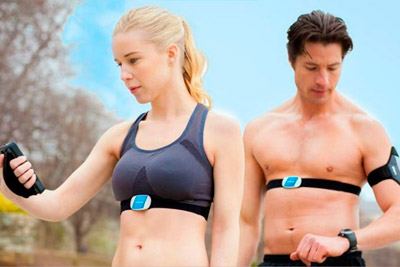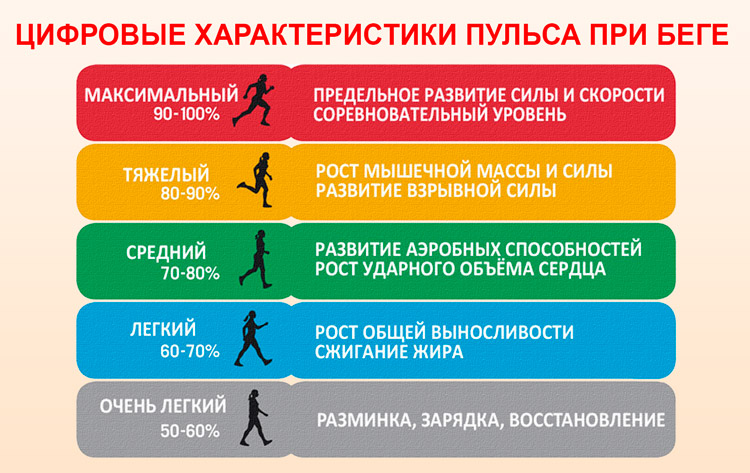Normal human heart rate during physical activity. Pulse while running: norms and violations
The pulse reflects the heart rate (HR). It is calculated by the number of beats (pulse waves) per minute. The indicator is influenced by physical activity, for example, running. If the heart rate is slightly higher than the permissible limit, then we're talking about about cardio training. Its significant increase can be dangerous, but it allows you to quickly increase strength and endurance. For beginners, it is advisable to consult a cardiologist and an experienced trainer to find out what the heart rate should be when running in an individual case. Experts will advise you to decide on the purpose of training (losing weight, pumping muscles, increasing overall tone) and be examined to rule out heart disease.
Heart rate while running and race walking must be maintained in order to more effectively achieve goals:
- burning extra pounds;
- stimulation of lung function;
- heart training;
Experienced athletes know how to best train their body, so they always keep their heart rate at a safe level. Otherwise, the likelihood of developing pathologies of the cardiovascular system increases. To prevent them, sports fans should find out everything about acceptable standards and maximum distances. Then calculate your heart rate norm, focusing on your goals, and move on to classes.
Factors affecting heart rate
Certain factors can affect the heart rate:
- stress;
- bad habits;
- human fitness;
- diseases;
- hormonal imbalances;
- environmental impact.
 Elderly people in a state of complete calm may have a reduced heart rate due to age-related changes. The cardiovascular system gradually wears out, which leads to the formation of foci of cardiosclerosis. They can distort the passage of the impulse and lower the heart rate. An elderly person's heart may respond to exercise with a sharp jump in heart rate, so it is necessary to remain vigilant and consult a cardiologist.
Elderly people in a state of complete calm may have a reduced heart rate due to age-related changes. The cardiovascular system gradually wears out, which leads to the formation of foci of cardiosclerosis. They can distort the passage of the impulse and lower the heart rate. An elderly person's heart may respond to exercise with a sharp jump in heart rate, so it is necessary to remain vigilant and consult a cardiologist.
In people who build muscle (bodybuilding) through strength training, runners and other athletes who experience serious cardio loads, it is common for low performance Heart rate. For them, a resting heart rate of 40 beats per minute will be considered normal. This is due to the fitness of the heart muscle. Due to constant exercise, it increases in size, which makes it possible to make fewer contractions to supply blood to the whole body. Thanks to this feature, normal pulse when receiving physical activity, athletes are lower than those of unprepared beginners.
U fat people normal heart rate at physical activity higher due to the amount of blood required to saturate all tissues. They have to take more frequent breaks during exercise to restore their breathing and heart rate. Trying with all your might to lose weight, increasing the pace of training, is contraindicated in order to avoid heart problems.
Bad habits (smoking, drinking alcohol) have a detrimental effect on the body, which can negatively affect heart rate and the speed of recovery after exercise. They also significantly increase the likelihood of developing atherosclerosis and other diseases.
A person who has recently experienced stress has an increased heart rate. He needs to calm down and only then start running.
Increased heart rate may be due to bad weather and various pathologies. In the first case, it is better for the athlete to wait good conditions for classes. If he has any health problems, he should definitely consult a doctor.
A teenager may feel an increased heart rate at the slightest exertion, which is associated with puberty. The situation gets worse if the child develops vegetative-vascular dystonia against this background. To avoid the consequences of tachycardia, it is necessary to reduce physical activity. Closer to adulthood (18 years), this problem will go away on its own.
Normal heart rate after physical activity in women and men
There are generally accepted indicators, based on which you can understand that it is worth reducing or increasing the load. They are shown in the table:
Up to 130 contractions per minute
- The heart muscle is strengthened, which helps improve blood supply to all tissues of the body and prevent diseases of the cardiovascular system.
- Lactic acid that accumulates due to strength training is eliminated.
- Weight loss (when training at a high pace for 20 minutes or more).
Even when jogging, it is virtually impossible to constantly maintain your heart rate at the same level. The athlete will sometimes have to switch to sports or regular walking, since the heart rate can be reduced when running only by reducing the pace. This is especially true on hill climbs.
Up to 145 hits
Jogging at a heart rate varying from 130 to 145 beats per minute is a preparatory exercise for experienced athletes. It helps warm up the body before strength training exercises. gym. Usually it is enough to run at a similar pace for about 4-5 minutes. The heart muscle will pump blood throughout the body, which will help you better tolerate heavy loads.
Usually it is enough to run at a similar pace for about 4-5 minutes. The heart muscle will pump blood throughout the body, which will help you better tolerate heavy loads.
It is impossible to unequivocally answer what the pace should be to maintain the pulse at the level of 130-145 beats per minute due to the individual characteristics of each person. In trained people, the number of contractions does not rise above 120 during a simple jog. Beginning athletes will have to slow down the pace. Even when running at an average pace, their heart rate gradually increases to 130-140 beats per minute. Much also depends on age.
In people over 45 years of age, the heart rate increases much faster than in 20-year-old boys and girls.
Up to 165 cuts
When running with a pulse wave frequency of 150-165 per minute, endurance increases. To adapt to extreme conditions, the body has to rebuild. Muscle tissue grow and new capillaries form in them.
For ordinary people who want to stay in shape and burn excess fat, all they need to do is run short runs at this pace. For professional athletes, maintaining a heart rate of 150-165 beats per minute is a prerequisite for a good workout.
Up to 180 hits
Speed training typically increases your heart rate to 180 beats per minute. In the case of running, we are talking about short-term (up to 2 minutes) acceleration. Then the pace is reduced to normal. Such “ragged” running promotes muscle growth, but requires the athlete to constantly monitor his pulse.
Features of measuring heart rate while running
 When exercising on an exercise bike or treadmill, a person can at any time check how many kilometers he has run, burned calories and his heart rate on the screen of the exercise machine. During a simple jog, it is advisable to use a heart rate monitor. It can be wired or wireless and is worn on the chest, wrist, finger or ear.
When exercising on an exercise bike or treadmill, a person can at any time check how many kilometers he has run, burned calories and his heart rate on the screen of the exercise machine. During a simple jog, it is advisable to use a heart rate monitor. It can be wired or wireless and is worn on the chest, wrist, finger or ear.
Without special instruments, you can measure the pulse by palpating the carotid (neck) or radial (wrist) artery. Count the number of beats for 10 seconds, and then multiply the result by 6.
It is advisable to control your heart rate not only while running, but also at rest. If the heart rate decreases slightly in the absence of physical activity, it means that the heart has adapted to sports and performs its functions more efficiently. If sudden changes in heart rate are detected, it is advisable to consult a cardiologist. It may be necessary to reduce the load.
When should you start monitoring your heart rate?
At the basic stage, when jogging is carried out over short distances at a slow and medium pace, it is better not to be interrupted by constant heart rate measurements, but to monitor the sensations. The appearance of heaviness in lower limbs and shortness of breath indicates excessive stress on the body. To avoid complications, the pace should be reduced.
For athletes who have been practicing cardio training for a long time, it is advisable to measure their pulse as often as possible. This measure is important to prevent exceeding 90% of the threshold (of the possible maximum).

Heart rate for beginners
For males, while running, the pulse should not exceed 115-125 beats per minute. Athletes are allowed a deviation of 5 contractions (120-130). Increase the limit after bringing the duration of the run to half an hour.
Increasing load
Beginner athletes should begin jogging or walking when they reach 125 beats per minute. It is permissible to return to the original load after reducing heart rate. You can gradually increase the upper limit to 130-135 contractions.
You can check whether the load is suitable by looking at the speed of recovery after training. If within 10 minutes the pulse does not drop to 60-80 beats, then the training program should be lightened (reduce the pace, distance).
Both beginners and experienced athletes are required to know what their heart rate should be. Based on this indicator, you can understand whether the heart has adapted to the load. If the number of heartbeats per minute increases (above the permissible limit), it should be reduced, and if it decreases, it should be increased.

It's no secret that in order to get rid of extra centimeters and fat in your body, you should train a lot. However, how do you know if you are training correctly or not? Have you put in enough effort to make your efforts worthwhile? Do you need to train hard? Or do you need to exercise in a gentle manner so that your body has rest?
How to calculate your heart rate?
It is believed that normal frequency pulse healthy person 70-90 beats per minute, but how can you calculate the only correct heart rate at which the optimal amount of fat in your body will be burned? And here comes the first problem - since there are two interchangeable theories regarding this issue, you will have to choose one of them. All we can do is introduce you to each of them.
Regarding the first theory, the correct pulse is low heart rate, since it burns much more fat. Proponents of this theory are nutritionists. And in some ways they are definitely right, since there is quite adequate evidence that with a low heart rate the body begins to feed on its own fats. There is also a miracle tablet that you simply need to familiarize yourself with.
| Pulse rate | Carbohydrates used,% | Fats used,% |
| Up to 80 | About 20 | About 80 |
| 124 | 65 | 35 |
| 142 | 74 | 26 |
| 159 | 90 | 10 |
If we decipher our table, we will clearly and clearly see that with a pulse rate of only 80 beats, the body uses as much as 80 percent of fats, burns them, and only 20 percent of carbohydrates that are valuable to us. But with a maximum number of 159 strokes, we have a not so positive result; it turns out that the body burns only 10 percent of fat, and 90 percent of useful carbohydrates. It is not for nothing that it is now so fashionable to exercise at a reduced pace, to get the lowest heart rate during training.
But even here there is one BUT - what to do with this famous formula for measuring heart rate, according to which 220-age * 70? What does it mean? Or has science gone far ahead and left it far behind?
Here we move on to the second controversial theory. This formula became famous thanks to its famous creator, in honor of which it received his name - the Karvonen formula. In fact, it is not so simple, because it has three options:
The so-called simple - as we have already mentioned (220 minus age) - is maximum heart rate during physical activity(MCP)
The so-called gender - (220 minus age) - PIL for men and (220 minus age minus 6) - PIL for women.
And the last one (the so-called complex) – (220 minus age minus resting heart rate)
So, in order to start burning fat, the optimal heart rate should be 60-80% of the highest. This means that if we translate this into the language of our formula, we get the result that you need to keep the optimal heart rate between (220 minus age) * 0.6 and (220 minus age) * 0.8. So we get that for a thirty-year-old lady, the optimal heart rate will be the one that is between (220-30) * 0.6 and (220-30) * 0.8. If we make simple mathematical calculations, we get the numbers 114 and 152. Finding the arithmetic average is not difficult - it will be 135 beats per minute.
So, the problem facing us says: if we train at a rate of 135 beats per minute (after all, this is the result that Karvonen’s formula showed us), then the greatest amount of fat will be burned. But if you trust nutritionists, then with such an intensity of exercise we will burn huge amount carbohydrates, and almost all fats will remain in their places, not counting the unfortunate 30 percent. And how do you know who to trust and who not? Who to consult?
And here it is - the answer. To be completely honest with you, we tell you with all responsibility that neither one nor the other can be trusted. Of course, somewhere deep down in their souls, both of them have some kind of common sense, but the result is simple. If you trust nutritionists, then even the simplest walking should bring stunning results. Although, according to our calculations, to get rid of half a kilo of fat at a normal walking speed of 3.2 kilometers per hour, you will have to walk 232 kilometers! So, to get real results, you will have to work hard one way or another.
And if you take a closer look at our formula, then there is no need to be clever here; the author himself sometimes doubts its plausibility, and constantly emphasizes its conventionality. One way or another, this formula has sunk into the soul of the population, and it is now used quite widely, in particular for calculating the PPP, although even a hedgehog understands that the result of this PPP should not be the result of subtracting age, but the result of the training of the individual himself (or his lack of training). Only from yours physical fitness and the maximum heart rate will depend, because all this is the result of your work. So, only specialized cardiological tests can help you determine this frequency, which will tell you the optimal frequency of your pulse, and not the pulse of a man or woman. And by the way, this result will constantly change, it is not given for life, so if you once did it, but decided to repeat your training results, we advise you to start by re-checking with cardio tests.
Another important indicator is the frequency of your training. American scientists have conducted research and shown that the most optimal frequency of training is from three to five times a week, it is during this time that your body has time to work hard and have plenty of rest. As they say, everything is good in moderation.
Healthy image life(HLS) is gaining popularity all over the world. At the same time, many are convinced that a healthy lifestyle is primarily about physical activity. That is why many people are fond of fitness centers, others run in the local forest. Unfortunately, not many people think about the fact that physical activity can be as harmful as it is beneficial, which is associated with physiological characteristics person.
These features are that heart And human muscles initially designed only for a certain number of contractions, as a result, by overloading an organ, you shorten its service life, rather than strengthen it. If everything is simple with the muscles of the body - you are engaged in mental work, therefore, no fitness center will allow you to exhaust their resources, but if your activity is physical labor, then additional physical activity as part of a healthy lifestyle will shorten both your youth and your life. With monitoring the activity of the heart, everything is somewhat more complicated. In medicine, they use as objective methods of monitoring - pulse, blood pressure, and instrumental - ECG, EchoCS. In routine methods of monitoring heart activity, the first two are used, and ECG and EchoCS (ultrasound of the heart) are used only when complaints or signs of any disease appear.
When executing physical activity you should monitor your pulse. For this purpose, built-in sensors in exercise equipment (for example, treadmills) or a special heart rate monitor can be used, of which there are a great variety on the market today.
The manuals suggest you navigate for formula 220 - human age when monitoring maximum heart rate. Maximum heart rate during physical activity is used by athletes, and not for those who receive physical activity for the sake of a healthy lifestyle. For example, if you are 30 years old, then your maximum heart rate will be 190 (220-30) beats per minute.
For all age categories you should be guided to a pulse of 150 beats per minute during any physical activity. Over time, as you train, you will notice that your heart rate tends to 130 beats per minute. You should increase the load if you are trying to reduce your body weight - to burn fat, it is better to maintain your heart rate at 150 beats per minute or higher. For all other purposes, a heart rate in the region of 130-140 beats per minute will be ideal for most people leading a healthy lifestyle.
You should not constantly increase the load as heart fitness. Don't forget, the best athletes in the world die a couple of months after leaving sports - sports are not a healthy lifestyle. A healthy lifestyle is a harmony of physical and mental activity.
- Return to section table of contents " "
